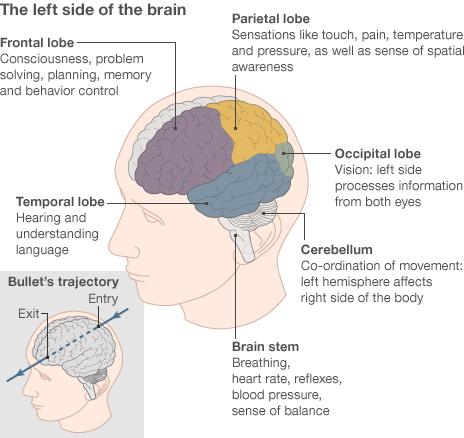Treating a gunshot to the head - extreme brain surgery
- Published

Two-thirds of people shot in the head never make it to hospital
Surgeons treating Gabrielle Giffords, the US congresswoman who survived a gunshot wound to the head, have had to remove half her skull in a bid to save her damaged brain.
But why is such an extreme step necessary?
Ms Giffords' doctors say she is incredibly lucky.
Despite a close-range bullet travelling through the left half of her brain, she has survived and is already responding to simple commands like squeezing of the hand.
Very few people with gunshot wounds like hers live through the ordeal.
But to save her life surgeons have had to use extreme measures - cutting away half of her skull and putting it on ice.
The technique, called a hemicraniectomy, may sound crude and barbaric to the untrained, but it could mean the difference between life and death for Ms Gifford.
Although she may have beaten the bullet, it is the damage it has left in its wake that her doctors now need to worry about.
Like any other part of the body, when the brain is injured it will swell.
But because it is housed in a bony box - the skull - the swelling has nowhere to go.
Left untreated, the pressure would mount and cause further damage to the jelly-like substance that is the brain.
Hole in the head
Excessive intracranial pressure can cause damage to delicate brain tissues leading to lasting disability. Even higher pressure can cause death.
Faced with this, doctors have few options other than to find a way to let the pressure out.
They can try drugs to take down the swelling or drain off some of the fluid that bathes the brain, but in extreme cases, surgery may be the only answer.
For the procedure, the surgeon removes a section of the skull - a "bone flap" - to give the swelling brain room to expand.
The bone flap removed is preserved in a fridge until it can replaced once doctors have the swelling under control.
Eventually it can be screwed back on using metal plates, which can be removed once the bone has knitted together.
Making a hole in the head is not a new idea. Surgeons have been doing it for centuries.
Evidence of trepanation, or making burr holes, has been found in prehistoric human remains from Neolithic times onward, using sharp objects like teeth as tools rather than the precision surgical saws and drills used today.
Historians believe the procedures were used to treat a range of ailments, possibly including mental illness as well as epilepsy and migraines.
While this sounds like something too dangerous to try in the days before modern medicine and the discovery of antibiotics, human remains show some patients did survive the operation.
Resting brain
Today, craniectomies are frequently used by military surgeons in Afghanistan to treat soldiers with severe traumatic brain injury due to bomb blast and high velocity penetrating missile injuries.
Indeed, Ms Giffords' trauma surgeon Dr Peter Rhee is a former military doctor who served in Afghanistan.

He told reporters that Ms Giffords was fortunate that the bullet had stayed on one side and had not hit areas of the brain that are almost always fatal.
Surgeons also did not have to remove much dead brain tissue, another positive sign.
But only time will tell how she will fare.
Swelling can take several days to peak, and may take more than a week to go down.
Ms Giffords is currently heavily sedated in a coma-like state that helps rest her brain.
An update from the doctors on her condition is expected later on Monday.
- Published10 January 2011
- Published10 January 2011
- Published9 January 2011
- Published11 January 2011
- Published10 January 2011
- Published2 August 2011